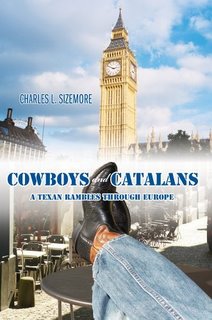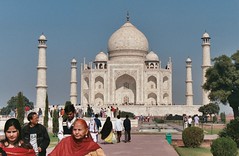Sunday, April 23, 2006
Shopping for clothes

It is seldom as easy as it looks in India where the problems brought on by a massive population explosion make it that much more important for anyone to sell as much and for as much as they can. This isn't your average tailor shop. The clothes are good, prices a bit high, and they are not necessarily used to handling people from western countries and their builds, but it's an experience worth doing. Once.
Delhi Days
BY MIKE McILVAIN
DELHI, India – Eye-to-eye contact with a nearby ear-flicking grey and white Brahma bull was too much like an instant from the rodeo, but there was no fence between it, two friends and myself.
This bull effectively said no more pictures without uttering a word. It was time to move on quickly without any sudden moves. This trip wasn’t about trying to be in a news story.
Small, ancient temples used as storage bins was the next surprise at the shopping area we visited while waiting for tailor-made suits to be finished.
Surprises in this very old city come at varying speeds, keeping everyone on their toes. Most of Delhi’s surprises start with the people and things they do.
Words, facial expressions, intimidation, diplomacy, tact, reason and prices all tie in in the never ending negotiations in this city, which has been India’s capital for more centuries than most of the 14 million here want to count. The newer part of the city is New Delhi – an English creation -- and the rest is just Delhi: made up of the cities founded by Indian leaders and mughals, consisting of the various enclaves and colonies.
Getting from enclave to enclave or anywhere to anywhere involves negotiating a cab fare, unless friends have a car and time to stop at the gasoline stations where they easily have one man for every pump. A lot of jobs are eagerly taken with millions all haggling over every rupee.
Negotiating, however, leads to discussions with a wide range of taxi drivers. Regular automobile taxis are too high for most travelers, demanding some 1,500 rupees from the airport to most anywhere in the city. Those handling the cyclerickshaws will work harder if you are a larger American, but your heart will work harder if not used to the traffic here.
Vehicles all too often appear as though they are going to sideswipe each other with eyes expanding and muscles tightening as your autorickshaw looks like it’s rearending whomever, or whatever, are ahead. But they don’t and the lesson is repeated over and over, but you still grip the front of your seat each time these gas-coughing vehicles converge on stoplights.
The only constant in negotiating in India is that foreigners are generally charged double of what the South Asian would be asked to pay and there is no such thing as a set price – with very few exceptions.
But negotiations can be fun, too.
Comical action between drivers vying for your attention pushing each other around contrasts the occasional bullying for more than the agreed price when the driver thinks your trip was a little more than he had imagined.
One should never forget that some of the world’s smartest scientist, doctors and business people come from this same South Asian gene pool. Never underestimate anyone you might be dealing with and any negotiating is best with a friend around to help.
A friend from France helped me get through an impasse in that suit-making clothing store in Green Park. The manager and head salesman was not getting off his point that I needed a grey suit, but it wasn’t worth the much higher expense to me. She broke it up, commenting that I’m under no obligation to buy anything at all, which brought the manager back down to earth in a hurry. He wasn’t looking for anything from the side, focusing on me and my money in a face-to-face hard sell.
I got a cheaper darker suit.
Other good things are found in Connaught Place, once past tricky Janpath where street people work together to cheat tourists out of their money, and at Dilli Haat – a shopping place with small regional restaurants from various parts of India and Tibet.
Connaught Place is probably one of the best places to change money, buy music, eat Western-style food and buy necessary items like shoes. And everyone knows where it is, but watch out for clever Janpath shoeshine men who have someone up the street toss cow dung on your shoe.
Most know where Dilli Haat is, but not as well. I got lucky with a very nice older Sikh gentleman who only wanted reasonable 40 rupees to drive me in his autorickshaw. He also helped me get past a street hustler before going on his way. A bigger, younger man, also wearing a turban, who drove me back to where I was staying in Pamposh Enclave, however, demanded an extra 10 rupees from me after the route proved to be longer than he envisioned.
Dilli Haat got good nods from others in Delhi at the same time. Its various shops carry a variety of goods in usually reasonable prices and there is considerably less intensive hardcore sales than elsewhere. Here one can sit down, rest and watch a fashion show and enjoy not being bothered.
Modern shopping mall Ansal, one of the few places with fixed prices, is good for luggage and numerous other things, including food, but it’s still a shopping mall much like those in the U.S. Ansal differs with its outdoor movie screen -- frequently flashing commercials for the latest Hindi-language pop album, clothing and the things one finds at the mall.
Delhi’s Red Fort, one of several around India, is a good site for sights, pictures and souvenirs as is India Gate, adjacent to the country’s seat of government. The Lotus Temple in Okhla Village is another recommended site.
Okhla Village is predominantly Muslim, but most everyone is too involved in their own busy, demanding lives to worry about anyone else. These are the tight, crowded streets limited to foot and cyclerickshaw traffic never seen in our world.
It was so tight riding on a cyclerickshaw with a college friend from the neighborhood that I couldn’t get my camera out of my pocket. Arms don’t hang outside the rickshaw if you want to keep them.
My friend Asad, also a newspaper editor, is wide open to discussing the world and its events, but some of the people we visited weren’t as talkative. That worried me a little, but something I saw almost every day clued me into the future of this very well populated, most often hot land.
Across the street from where I stayed is a school where boys worked feverishly in their recess periods on cricket. Cricket is a parent sport of baseball, involving plenty bat and ball skills, and much like boys in this country in earlier decades who took their gloves to school there is a visible intensity in working to master the sport. Those boys worked on their skills every chance they got.
It’s already very tough to keep your money in India, despite a great exchange rate, and these cricket players have the skills and work ethic to accomplish plenty.
And, I would like to go back someday.
Saturday, April 22, 2006
Review of Cowboys and Catalans

By MIKE McILVAIN
"Cowboys and Catalans"
iUniverse; on Amazon.com, Barnesandnoble.com and other major booksellers, $19.95.
Texan Charles L. Sizemore showed what a person can do for themselves and, potentially, their future in one year’s time in "Cowboys and Catalans."
Sizemore made a few mild errors, but otherwise wrote an outstanding travel literature book for a first-time author.
"Cowboys and Catalans" should be read by anyone who ever considered furthering their education overseas, or thought of sending their grown children there. "Cowboys" is smooth and flows, grabbing the reader and not letting go.
Sizemore makes a reader wish there was another adventure, another country, another girlfriend or another beer drinking buddy to read about.
Sizemore, a Texas Christian University graduate, finds his natural native Texan curiosity for Spain transforms into a love for that country through its people, its language, which he also speaks, and the food. Sizemore’s emotional draw to his Spanish friends and others from around the world adds to the emotional advantage this book has over numerous others in the same genre.
He said goodbye to his Spanish friends last, as the book was arranged, and it wasn’t easy.
"Before meeting each other we had reached a common point in which our lives had become stale. London had given us the fresh beginning we desperately craved, and now it would be time for another major change in my life.
"I had dreaded this moment since my arrival in Spain," he wrote. "It was more than a goodbye to two close friends; it was a sad reminder that the end of my escape was fast approaching. I grabbed Paula with my right arm and José Manuel with my left and gave them both a big Spanish abrazo before boarding my bus to San Sebastian."
Sizemore very wisely realized his unique situation when studying at LSE, living at the Barbican YMCA and traveling Europe. He said he did some work on the book while still overseas before returning to his financial world, and all the daily time-consuming trappings, which don’t allow much time to write a book.
Once in a rare while a book hits its reader right in his own neighborhood. Literally. Sizemore lived about half a mile from where I stayed in London during the 2001-2002 academic year, and I am sure we knew several of the same sites and establishments there and on the continent.
I can say with authority that Sizemore nailed the overseas higher education experience, which deems attention from the U.S. academic community, too.
The only major point Sizemore didn’t press was the cost, which despite the terrible exchange rate with the weak dollar against the almighty British pound, is still cheaper than most master’s degrees here in this country.
Tuesday, April 18, 2006
Laredos to be seen
on travel show
SILVER SPRINGS, Md. -- Laredo and Nuevo Laredo will be seen on the Travel Channel on May 22.
Local restaurants are featured in No Reservations, hosted by Anthony Bourdain. No Reservations airs at 9 p.m. Central Time each Monday.
Bourdain is in Sweden in next Monday's show.
Friday, April 14, 2006
018_15A
It's the Taj Mahal and quite a sight of a site to see. The only down note is the battle one has to go through to see it, getting past the sometimes very aggressive souvenir hawkers and overcharging guides, which take you to overcharging arts and crafts sales people. And they sell very hard, not letting up at all. But India is an incredible place and I hope to see it again some day.
Baalbek
 Baalbek, out in Lebanon's Bekaa Valley, where several feared to tred in more turbulent times, was one place I saw there in late 2002 thanks to friend Rabih. Actually, Baalbek is the more photogenic of the major sites I saw there, but Byblos is the most impressive where 17 civilizations have laid claim to the little finger peninsula.
Baalbek, out in Lebanon's Bekaa Valley, where several feared to tred in more turbulent times, was one place I saw there in late 2002 thanks to friend Rabih. Actually, Baalbek is the more photogenic of the major sites I saw there, but Byblos is the most impressive where 17 civilizations have laid claim to the little finger peninsula. 



